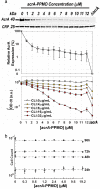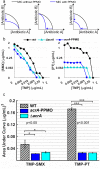Sequence-Specific Targeting of Bacterial Resistance Genes Increases Antibiotic Efficacy
- PMID: 27631336
- PMCID: PMC5025249
- DOI: 10.1371/journal.pbio.1002552
Sequence-Specific Targeting of Bacterial Resistance Genes Increases Antibiotic Efficacy
Abstract
The lack of effective and well-tolerated therapies against antibiotic-resistant bacteria is a global public health problem leading to prolonged treatment and increased mortality. To improve the efficacy of existing antibiotic compounds, we introduce a new method for strategically inducing antibiotic hypersensitivity in pathogenic bacteria. Following the systematic verification that the AcrAB-TolC efflux system is one of the major determinants of the intrinsic antibiotic resistance levels in Escherichia coli, we have developed a short antisense oligomer designed to inhibit the expression of acrA and increase antibiotic susceptibility in E. coli. By employing this strategy, we can inhibit E. coli growth using 2- to 40-fold lower antibiotic doses, depending on the antibiotic compound utilized. The sensitizing effect of the antisense oligomer is highly specific to the targeted gene's sequence, which is conserved in several bacterial genera, and the oligomer does not have any detectable toxicity against human cells. Finally, we demonstrate that antisense oligomers improve the efficacy of antibiotic combinations, allowing the combined use of even antagonistic antibiotic pairs that are typically not favored due to their reduced activities.
Conflict of interest statement
MW and SMB are employees of Sarepta Therapeutics that hold numerous patents on the methods of synthesis and use of PPMOs. DEG receives research support from Sarepta Therapeutics, holds several patents related to PPMOs, and receives license-related royalties for these. All other authors declare no competing financial interest.
Figures





References
MeSH terms
Substances
Grants and funding
LinkOut - more resources
Full Text Sources
Other Literature Sources
Medical

